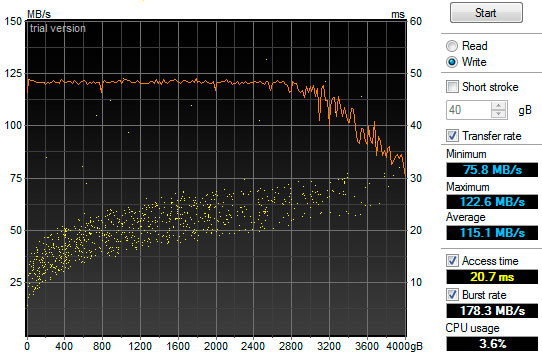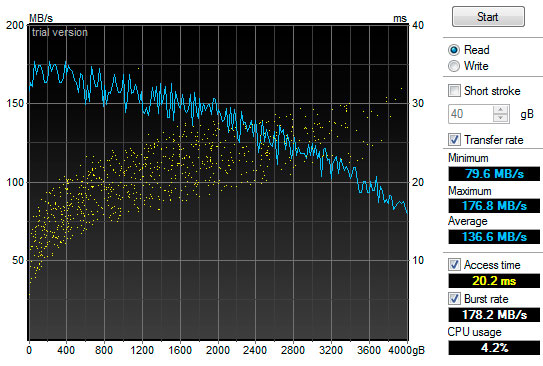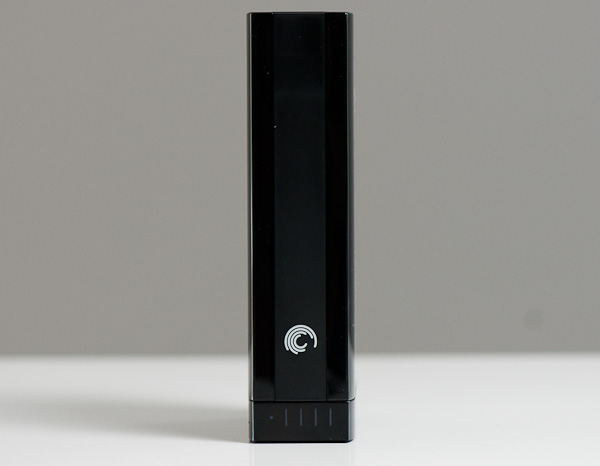Seagate's GoFlex Desk 4TB External HDD Review
by Anand Lal Shimpi on September 10, 2011 9:27 PM EST- Posted in
- Storage
- Seagate
- GoFlex Desk
- 4TB
Performance
There's no point in looking at USB 2.0 performance since all drives there are limited to under 40MB/s thanks to the speed of the interface. Over USB 3.0 however we're able to talk to the drive at much closer to its native performance:
| Windows 7 Performance Comparison | |||||
| Seagate GoFlex Desk 4TB (USB 3.0) | Seagate GoFlex Desk 3TB (USB 3.0) | ||||
| Sequential Read | 174.6 MB/s | 151.9 MB/s | |||
| Sequential Write | 137.2 MB/s | 151.2 MB/s | |||
| Random Read | 0.21 MB/s | 0.30 MB/s | |||
| Random Write | 1.14 MB/s | 0.93 MB/s | |||
Sequential read speeds are very high over USB 3.0 at 174.6MB/s. Oddly enough sequential write speeds are noticeably lower, perhaps a limitation introduced by the USB 3.0 controller inside the GoFlex dock. Max sequential write speed is lower than last year's 3TB model while read performance is improved.
Random performance is also a mixed bag. We got better random write performance but slightly lower random read performance than last year's 3TB model.
We turned to HD Tune once again to plot out performance vs. logical block address. Last year we had a somewhat odd graphs from the 3TB drive where performance dropped down to 16MB/s as we wrote to the inner most tracks of the platters. The 4TB solution doesn't have that problem but it does exhibit its own strange behavior:

Write performance remains relatively flat over the majority of the LBA range of the drive. Performance should decrease almost linearly but instead we get consistent performance across the first ~3TB of the drive. It's only in the last 1TB that performance falls down to 75.8MB/s. As I mentioned before, I suspect we may be bottlenecked writing to the GoFlex's USB 3.0 controller which results in this behavior.

Read performance is both higher and linear, indicating once again this issue seems to only limit write speed.
If you're migrating from a 3TB GoFlex Desk, do expect to see a tangible decrease in write speed but once you've got your data on the drive expect to be able to read it back faster.
Final Words
As the world becomes more mobile, external storage becomes even more important. Having moved to a notebook-as-a-desktop usage model myself, I completely understand the need for high capacity external drives.
Seagate is certainly pushing the envelope when it comes to capacity with the GoFlex Desk. Just a few years ago I had to build a file server with multiple drives to reach 4TB and today Seagate is delivering it in a small, single drive enclosure. If you need a ton of storage in a relatively compact space, the 4TB GoFlex Desk gets the job done.
The usual caveats apply however. There's always a price premium for these high capacity external drives, although Seagate is only charging an extra $50 for the 4TB version compared to the 3TB model. If you wanted to buy a standalone drives however you could easily buy two 2TB HDDs for less than half the cost of this 4TB external drive. Granted there is the convenience of having an all-in-one package with a single drive but you're almost always better off financially buying internal drives and sticking them in a cheap chassis. Then there's the problem of finding a good way to back up 4TB worth of data.
Finally there's the issue of cooling. If you're going to be constantly reading/writing terabytes of data from/to the GoFlex Desk then you'll want to look elsewhere. Seagate's modified chassis does keep the drive cooler than its predecessor but it's just not designed for extended heavy use. Google's study on hard drive reliability showed that average temperatures above 45C corresponded with an increase in failure rate, particularly for drives that had been running for 3 or more years.
I suspect most users of the GoFlex Desk will be fine however. Moving a couple hundred GBs here or there never resulted in any dangerously high temperatures. Given that this isn't an enterprise drive, I wouldn't expect most users to continuously write 1TB to the drive with any sort of regularity.











34 Comments
View All Comments
Mitch89 - Saturday, September 10, 2011 - link
The swappable interfaces is an interesting idea, but wouldn't it just make sense to make it FW800/USB3 standard, instead of messing about with different adaptors?dagamer34 - Sunday, September 11, 2011 - link
It's not hard to imagine a Thunderbolt adapter. FW800/USB3 are great but they have their disadvantages. Same with eSATA.FW800 - slow, hard drive is faster than the bus.
USB 3.0 - while fast, it requires traveling over the USB protocol, which is at the mercy of the quality of your USB 3.0 controller.
eSATA - fine for desktops, but may not be present on laptops.
Thunderbolt - can be part of a daisy chain, which reduces the number of wires coming out of a laptop.
Guspaz - Monday, September 12, 2011 - link
On the contrary, eSATA is far more common on laptops than desktops (although it's simple to add to desktops with cheap adapters); eSATAp ports (hybrid USB/eSATA ports that can provide power) are very common on laptops these days.While a thunderbolt adapter for the GoFlex drives might be convenient, it's not going to get you any performance over eSATA; the GoFlex drives basically just provide a mechanical standard that lets the adapter plug right into the drive's SATA port via modified eSATA. This means that an eSATA adapter for the GoFlex is entirely passive (being the native format of the drive), while a Thunderbolt adapter is going to be active. At that point, the real question is, which controller will be better; your laptop/desktop's SATA controller, or Seagate's Thunderbolt controller (which will be doing the same thing, SATA-to-PCIe)?
Jaybus - Wednesday, September 14, 2011 - link
USB 3 can also connect to a hub. I think the author is far too quick to blame USB 3 for the performance issue with the last TB of the drive. I can think of no reason why the USB 3 controller should know or care which tracks of the drive the read heads happen to be over. I disagree with the author's assumption that the USB 3 controller is to blame. We can't know for sure, because it was deemed that USB 2 testing was not needed and neither was the drive removed from the case and tested in native SATA.seapeople - Wednesday, September 14, 2011 - link
He's not blaming USB 3.0 for the low performance at the end of the drive, he's blaming it for bottlenecking the performance at the beginning of the drive. The write speed should decrease linearly as the drive fills up due to the physics of data storage on a rotating platter, but the fact that it doesn't decrease for 3TB means something is limiting the drive's performance.sheh - Saturday, September 10, 2011 - link
I'm guessing Firewire is for the Apple people?logic_88 - Saturday, September 10, 2011 - link
What's the advantage of GoFlex over something like a SATA dock? I have a couple of triple interface SATA docks (USB2, eSATA, FW400) and it's easy to swap bare SATA drives whenever I want more/different storage.TypeS - Sunday, September 11, 2011 - link
Are you really asking that question? The GoFlex is not a dock, it is a packaged external drive with changeable interfaces. A a dock is a dock, a stationary device/tool.logic_88 - Sunday, September 11, 2011 - link
Since the GoFlex has a power brick, I don't see how it's any more portable than my dock.enderwiggin21 - Monday, September 12, 2011 - link
Fair enough, but essentially what you're asking is what's the point of ANY external drive when you can just use a dock. The answers to that shouldn't be too hard to figure out. Off the top of my head:Heat dissipation. Bare drives in my dock always run about 10 degrees cooler than drives I use that are actively cooled or have heatsinks attached to them.
Noise.
Protection.
And Dock + Power Cable + Drive + Cables = at least 1 more item to carry around than any external drive.